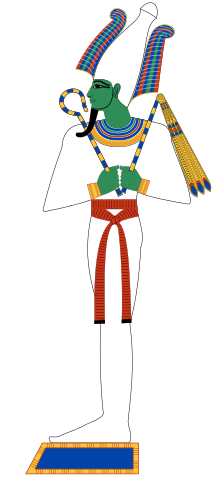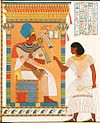
Osiris was the god of fertility, agriculture, the afterlife, the dead, resurrection, life, and vegetation in ancient Egyptian religion. He was classically depicted as a green-skinned deity with a pharaoh's beard, partially mummy-wrapped at the legs, wearing a distinctive atef crown, and holding a symbolic crook and flail. He was one of the first to be associated with the mummy wrap. When his brother Set cut him up into pieces after killing him, with her sister Nephthys, Osiris' wife, Isis, searched all over Egypt to find each part of Osiris. She collected all but one – Osiris’s genitalia. She then wrapped his body up, enabling him to return to life. Osiris was widely worshipped until the decline of ancient Egyptian religion during the rise of Christianity in the Roman Empire.
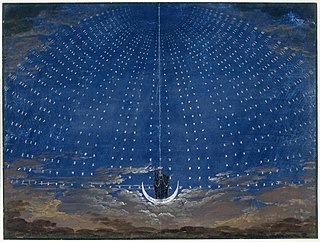
The Magic Flute, K. 620, is an opera in two acts by Wolfgang Amadeus Mozart to a German libretto by Emanuel Schikaneder. The work is in the form of a Singspiel, a popular form during the time it was written that included both singing and spoken dialogue. The work premiered on 30 September 1791 at Schikaneder's theatre, the Freihaus-Theater auf der Wieden in Vienna, just two months before the composer's death. It was the last opera that Mozart composed. The opera was an outstanding success from its first performances, and remains a staple of the opera repertory to this day.
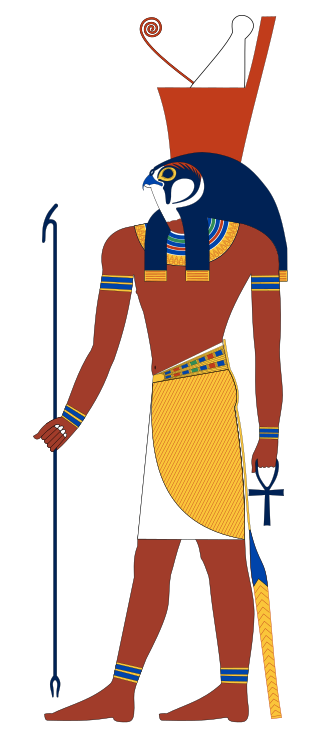
Horus, also known as Heru, Har, Her, or Hor in Ancient Egyptian, is one of the most significant ancient Egyptian deities who served many functions, most notably as the god of kingship, healing, protection, the sun, and the sky. He was worshipped from at least the late prehistoric Egypt until the Ptolemaic Kingdom and Roman Egypt. Different forms of Horus are recorded in history, and these are treated as distinct gods by Egyptologists. These various forms may be different manifestations of the same multi-layered deity in which certain attributes or syncretic relationships are emphasized, not necessarily in opposition but complementary to one another, consistent with how the Ancient Egyptians viewed the multiple facets of reality. He was most often depicted as a falcon, most likely a lanner falcon or peregrine falcon, or as a man with a falcon head.

Seker is a hawk or falcon god of the Memphite necropolis in the Ancient Egyptian religion, who was known as a patron of the living, as well as a god of the dead. He is also in some accounts a solar deity as for The Temple of Seker in Memphis.
The Ennead or Great Ennead was a group of nine deities in Egyptian mythology worshipped at Heliopolis: the sun god Atum; his children Shu and Tefnut; their children Geb and Nut; and their children Osiris, Isis, Set, and Nephthys. The Ennead sometimes includes Horus the Elder, an ancient form of the falcon god, not the son of Osiris and Isis.
The djed, also djt is one of the more ancient and commonly found symbols in ancient Egyptian religion. It is a pillar-like symbol in Egyptian hieroglyphs representing stability. It is associated with the creator god Ptah and Osiris, the Egyptian god of the afterlife, the underworld, and the dead. It is commonly understood to represent his spine.
The term "high priest" usually refers either to an individual who holds the office of ruler-priest, or to one who is the head of a religious organisation.

Hedjkheperre Setepenre Takelot I was an ancient Libyan ruler who was pharaoh during the Twenty-second Dynasty of Egypt.

The Stele of Ankh-ef-en-Khonsu or Stele of Revealing is a painted, wooden offering stele located in Cairo, Egypt. It was discovered in 1858 by the French Egyptologist François Auguste Ferdinand Mariette at the mortuary temple of the 18th Dynasty Pharaoh Hatshepsut, located at Deir el-Bahari. It was originally made for the Montu-priest Ankh-ef-en-Khonsu i, and was discovered near his coffin ensemble of two sarcophagi and two anthropomorphic inner coffins. It dates to circa 680–70 BCE, the period of the late 25th Dynasty/early 26th Dynasty. Originally located in the former Boulaq Museum under inventory number 666, the stele was moved around 1902 to the newly opened Egyptian Museum of Cairo, where it remains today.
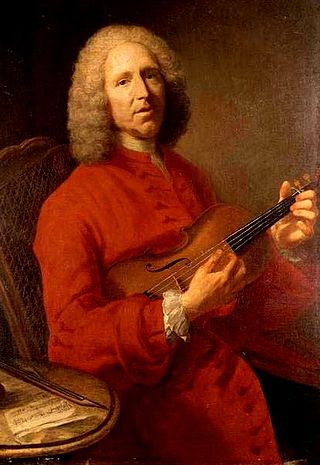
Les fêtes de l’Hymen et de l’Amour, ou Les dieux d'Egypte is an opéra-ballet in three entrées and a prologue by the French composer Jean-Philippe Rameau. The work was first performed on March 15, 1747, at the La Grande Ecurie, Versailles, and is set to a libretto by Louis de Cahusac. The opera was originally composed as part of the celebrations for the Dauphin’s marriage to Maria Josepha of Saxony. Les fêtes de l’Hymen proved to be a popular work and by the March 1776 it had been performed exactly 106 times. The librettist, Cahusac, was especially pleased with the ways in which he had succeeded in giving especial import to the supernatural elements of the work—the plot is based on Egyptian mythology—and to allow particular use of impressive large-scale stage machinery, which was much admired by the audience. The opera contains seven ballets, a consequence of Cahusac’s desire to further integrate dance and drama, which grew from the typical French devotion to ballet, particularly when allied with opera.
The Neshmet bark was a vessel belonging to the god Nun. The ancient Egyptian deity Osiris was transported in it on the river Nile during the Osiris festival at Abydos. The god's departure from his temple, journey to his tomb, and triumphant return were enacted and drew many spectators who participated in the public parts of the mysteries.

Imhotep is the main antagonist of the 1932 film The Mummy. He is also the main antagonist in the 1999 remake and its 2001 sequel The Mummy Returns. Sofia Boutella plays a female version of this character named Ahmanet in the 2017 reboot. Imhotep is loosely inspired by the historical figure Imhotep, a noted polymath and counselor to the Pharaoh Djoser in the 27th century BC.
The ancient Egyptian noble Prehotep I was Vizier in the latter part of the reign of Ramesses II, during the 19th Dynasty.

The mysteries of Isis were religious initiation rites performed in the cult of the Egyptian goddess Isis in the Greco-Roman world. They were modeled on other mystery rites, particularly the Eleusinian mysteries in honor of the Greek goddesses Demeter and Persephone, and originated sometime between the third century BC and the second century CE. Despite their mainly Hellenistic origins, the mysteries alluded to beliefs from ancient Egyptian religion, in which the worship of Isis arose, and may have incorporated aspects of Egyptian ritual. Although Isis was worshipped across the Greco-Roman world, the mystery rites are only known to have been practiced in a few regions. In areas where they were practiced, they served to strengthen devotees' commitment to the Isis cult, although they were not required to worship her exclusively, and devotees may have risen in the cult's hierarchy by undergoing initiation. The rites may also have been thought to guarantee that the initiate's soul, with the goddess's help, would continue after death into a blissful afterlife.

Wenennefer was an ancient Egyptian High Priest of Osiris at Abydos, during the reign of pharaoh Ramesses II of the 19th Dynasty.

Yuyu was an ancient Egyptian High Priest of Osiris at Abydos, during the reign of pharaohs Ramesses II and possibly Merenptah of the 19th Dynasty.
Qeni was the Superintendent of the Granary during the reign of Ramesses II. Qeni and his family came from Asyut.
Hori was an ancient Egyptian High Priest of Osiris at Abydos, during the reign of pharaohs Ramesses II.
Mery was an ancient Egyptian High Priest of Osiris at Abydos, during the reign of pharaoh Sety I and Ramesses II of the 19th Dynasty.
